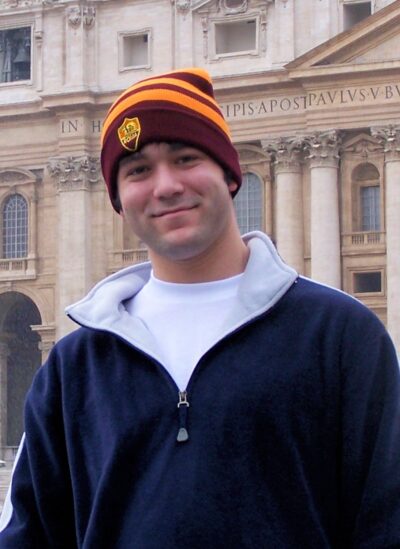
Matthew Milam’s parents sued hospital after doctors ignored warning signs their son was suicidal. No one listened. (Photo courtesy of Pat and Debbie Milam)
(12-15-23) Pat Milam was desperate. He knew his adult son, Matthew, was planning on killing himself. But doctors at the Ochsner Hospital/Clinic where his hospitalized son was being treated for bipolar disorder and paranoid sczhophrenia weren’t listening.
The more Pat tried to sound alarms, the more doctors at the large medical center on the outskirts of New Orleans, La., balked. One said he didn’t want to “upset” Matthew by sharing his father’s worries. But mostly, Pat and his wife, Debbie, were told the federal Health Insurance Portability and Accountability Act (HIPAA) prevented the hospital from discussing Matthew’s case.
“I told them, you don’t need to tell me a damn thing about my son,” Pat recalled in a telephone call. “I know my son. You need to let me tell you about what is happening on the other side” – at home.
“I took photos of Matthew standing in a thunderstorm begging God to strike him down by lightening,” Pat explained, hoping to substantiate his fears. “I got a notarized affidavit from a co-worker who described how Matthew had showed him a noose and said he was going to use it to kill himself. I documented how Matthew had dug his own grave in our backyard and had slashed his throat.” Pat went so far as to get a letter a psychiatrist not affiliated with Ochsner stating that Pat was not an “alarmist” but had reasons to be worried.
Pat hand-delivered all of those documents to Ochsner. Despite this, he was told that Matthew would be discharged. Doctors said he was stable. Pat contacted the CEO of Ochsner and begged him to intervene – as one parent to another. No one listened.
Eight days after being sent home, Matthew was dead at age 24.
Grieving, heartbroken and angry, Pat sued Ochsner Medical Institutions, one of the largest providers in the South. It was a David vs Goliath challenge – Ochsner is a four billion dollar operation with 30,000 employees.
Now, twelve years after Matthew’s suicide and despite repeated attempts by Ochsner lawyers to drag out the couple’s civil suit, depose them with embarrassing questions about their personal lives, and drive up attorney bills, Pat and Debbie reached a settlement.
HIDING BEHIND HIPAA/ NOT SHARING INFORMATION
Over the years, I have received dozens of phone calls and emails from angry family members whose loved ones have ended their own lives after being discharged from psychiatric hospitals. While it is difficult to predict both dangerousness and suicides there is a commonality in many of these cases. The doctors and clinicians refused to listen to warning signs told them by parents and caregivers. Too often, clinicians cite HIPAA, which is commonly misunderstood.
Pat Milam – self-admittedly is bull headed. What makes his story different is that he sued, refused to back down, and demanded that the settlement be made public. (You can get a copy of the settlement by contacting Pat directly at pmilam@cox.net.) That document shows Ochsner agreed to pay a small sum to the Milams, which covers only a portion of their legal bills. But what’s important, Pat told me, is that the medical company has agreed to several policy changes that he and Debbie demanded.
According to the settlement, Ochsner’s Department of Psychiatry must devote one of its “Grand Rounds” teaching seminars for its doctors to “patient family/provider relations,” including best practices in communicating with family members about a patient’s history, including accepting information about previous suicide attempts and other warning signs.
Ochsner further agreed to place documents/information provided by family members/caregivers into a patients’ electronic medical record unless there is a “good faith, medically based reason not to do so.”
Finally, Ochsner doctors must share information which they receive from parents/caregivers with their fellow doctors. Put simply, doctors have to listen to parents/caregivers and share what they say.
Listening to concerns by parents/caregivers and exchanging that information among themselves might seem to be common sense steps, but Pat and Debbie discovered during their lawsuit, that Ochsner doctors didn’t do it. For instance, Ochsner doctors didn’t share any information with Matthew’s primary care psychiatrist. Nor did Ochsner doctors forward troubling information about Matthew to the outpatient clinic that was supposed to treat him after he was discharged from the hospital. One Ochsner doctor acknowledged that he didn’t know what to do with information that Pat had collected warning him about Matthew’s suicidal thoughts so that doctor simply put it in a file and took it home with him.
During depositions, Pat said he learned an especially infuriating fact. Ochsner doctors said HIPAA prevented them from talking to Pat and Debbie. But records showed Matthew had signed a HIPAA wavier authorizing doctors to discuss his case with his parents.
PLENTY OF WARNING SIGNS – WAS ANYONE LISTENING?
On June 14, 2011, Matt drove to an emergency room and told doctors that his “brain was leaking.” He demanded a brain scan. The scan failed to detect a lesion or leakage, but the doctors noted in their report that Matt appeared to be paranoid and delusional. Matt even asked the doctors to prove they were really doctors. He was sent home without treatment.
Not long after that, Pat discovered Matt in the family’s backyard digging a grave. “He said it was where he wanted to be buried after he killed himself.” That prompted Pat to send his son’s primary psychiatrist a note but he received no response.
A month later, Matt slashed his throat while talking to his mother in the kitchen. He’d lost nearly two liters of blood by the time he was admitted into the hospital. He told doctors he’d hurt himself because “men in a black car” that drove past their house were after him. Matt stayed at the hospital in a locked ward a few days, took his meds, did better and was discharged back to his primary psychiatrist.
A few weeks later, Matt’s primary psychiatrist noted that Matt remained an “extremely high… risk for suicide or other bad outcome.” But that information was not shared with Pat and Debbie, or later with other doctors. A month later, that same doctor noted that Matt displayed “hypo-manic activity…his mind just goes from one thing to the next.” Again, nothing was shared with Pat or Debbie or hospital doctors.
PARENTS TRIED TO KEEP MATT IN HOSPITAL
Matt’s behavior turned violent. He broke a pair of scissors and threatened to “kill his parents.” He accused Debbie of being the devil. One afternoon, Pat decided to inspect his son’s bedroom when Matt left the house to take the family dog on a walk. Inside a closet, he found two gallon gasoline cans with petrol, large BBQ size propane tanks, flares, a propane torch, rat poison and a shotgun shell. Pat called the police but was told there wasn’t anything illegal about storing flammables in a bedroom closet, since his son lived there. When Pat confronted Matt, his son became angry and threw a portable phone at his father. The police took Matt to a hospital emergency room where he was placed under a psychiatric hold (PEC) at Ochsner.
Pat asked to meet personally with the doctors treating Matthew. They declined, citing HIPAA. He contacted his local Congressman to get clarity about HIPAA rules. The congressman’s aide said they didn’t understand HIPAA either. Pat sent a fax to the hospital’s CEO asking that he and Debbie be allowed to talk to the team evaluating their son. No one responded.
According to the medical records, Matt was telling Ochsner doctors that his parents were overreacting. He added that he “didn’t believe mental illnesses were real.” The medical team evaluating Matt noted in his chart that his judgment was “poor’ but despite this, doctors began planning discharge procedures. Pat was furious. “He wasn’t ready.” In total, Matt had been in the hospital five days – longer than many PEC holds.
Because Matt was being discharged to his parent’s house, Pat was able to attend his son’s discharge meeting with doctors. “Your son is stable—we need to release him, the insurance company will pay for one more day,” Pat said he was told. “The doctors and insurance company said they ‘knew better’ than us. They refused to listen to us and our repeated warnings. It was all about money. We were his parents. We loved him and wanted to protect him. But he was being released and there was nothing we could do to stop it. The doctor’s told me that my son had promised to take his medication, and they had developed a “delicate bond with him”….. and there were no signs that Matt was dangerous or suicidal. I said, ‘Bullshit. My son won’t take his meds…He will kill himself!…One of Matt’s friends had visited him two days before and Matt had complained that he’d seen FBI agents wearing invisible raincoats walking inside the hospital.”
Once discharged, Matt agreed to report to an outpatient treatment center. His mother drove him but he insisted she stay in the car. He told the staff that he was upset because his girlfriend had broken up with him. No one from the hospital had forwarded any of the doctor’s notes or Pat’s warnings about Matt’s suicidal thoughts and attempts. “My son lied about a girlfriend and was sent home.” He refused to take his medications, and the meds he had taken at the hospital were wearing off as was expected,” Pat recalled.
Eight days after Matt was discharged, he offered to cook his father breakfast. After he fixed scrambled eggs, he announced that he was going upstairs to get ready for his outpatient therapy class. Before leaving the kitchen, Pat gave Matt a hug and told him “I love you”. Inside his bedroom, Matt opened the valves on the propane tanks, took the caps off the gas cans and fired a home made shotgun shell device killing himself. His father heard the nose, raced upstairs and found him dead.
Pat said that he sometimes wonders if the lawsuit was worth it. It was embarrassing and hurtful having Ochsner’s lawyers grill them during depositions about their marriage, personal lives, parenting skills – even each of their driving records. “Nothing will bring Matt back but we hope these policy changes will help someone in the future so they don’t have to go through what we did. If that happens, then yes, it was worth it. ”
Since the settlement was reached, Pat has contacted the Louisiana Governor’s office to push for the Ochsner policy changes to be required throughout the state. He and Debbie also are reaching out to their U.S. Senators and Representatives.

Pat and Debbie Milam wanted doctors to listen to parents/caregivers and not “hide” behind HIPAA



